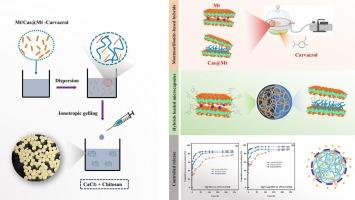carvacrol负载蒙脱石-酪蛋白酸盐杂交体作为活性添加剂开发海藻酸盐-壳聚糖抗菌微胶囊
IF 5.8
2区 地球科学
Q2 CHEMISTRY, PHYSICAL
引用次数: 0
摘要
本研究提出了一种新的方法来封装香芹酚,一种具有抗菌性能的挥发性化合物,使用蒙脱土基杂化材料,通过真空蒸发-吸附工艺在室温下制备。将这些杂合物作为活性添加剂掺入海藻酸壳聚糖微胶囊中。通过制备两种负载卡罗罗的蒙脱土表面功能化的效果进行了研究:一种是将酪蛋白酸钠嵌入到粘土层中,另一种是将酪蛋白酸钠吸附到外表面。其中,插层复合材料(Cas0.5@Mt-3)对香芹酚的吸附量最高,达到176.87 mg/g,而未改性粘土的吸附量为155.83 mg/g。这种增强是由于carvacrol扩散到层间空间,XRD分析表明层间空间增加。将负载香芹酚的杂交种以三种浓度(1%、2%和3% w/w)的海藻酸盐基质中通过离子化凝胶形成稳定的微胶囊。FT-IR和TGA分析证实,这种杂化复合材料具有更高的包封效率和负载能力,这可能是由于酪蛋白酸盐的两亲性,从而改善了添加剂与聚合物基体之间的相容性。在模拟食物介质中的体外释放研究表明,在水介质中,香芹酚的释放更受控制,而酸性和油性条件下,香芹酚的扩散速度更快。对选定菌株的抗菌试验表明,由于香芹酚和聚合物组分,特别是用于交联的壳聚糖的协同作用,抑制作用增强。这些结果支持了该方法的有效性及其开发活性聚合物体系的潜力,以提高香芹酚在食品相关应用中的生物利用度。本文章由计算机程序翻译,如有差异,请以英文原文为准。

Carvacrol-loaded montmorillonite–caseinate hybrids as active additives for the development of antimicrobial alginate-chitosan microcapsules
This study presented a novel approach for encapsulating carvacrol, a volatile compound with antimicrobial properties, using montmorillonite-based hybrid materials prepared via an evaporation–adsorption process under vacuum at room temperature. These hybrids were incorporated as active additives into alginate-chitosan microcapsules. The effect of montmorillonite surface functionalization was examined by preparing two types of carvacrol-loaded composites: one with sodium caseinate intercalated within the clay layers, and another with caseinate adsorbed onto the external surface. Among these, the intercalated composite (Cas0.5@Mt-3) showed the highest carvacrol adsorption capacity, reaching 176.87 mg/g compared to 155.83 mg/g for the unmodified clay. This enhancement was attributed to the diffusion of carvacrol into the interlayer space, as supported by XRD analysis showing increased interlayer spacing.
The carvacrol-loaded hybrids were incorporated into alginate matrices at three concentrations (1 %, 2 %, and 3 % w/w) using ionotropic gelation to form stable microcapsules. Higher encapsulation efficiency and loading capacity were achieved with the hybrid composites, likely due to the amphiphilic nature of caseinate, which improved compatibility between the additive and the polymeric matrix, as confirmed by FT-IR and TGA analysis.
In vitro release studies in food-simulating media revealed more controlled carvacrol release in aqueous medium, while acidic and oily conditions led to faster diffusion. Antimicrobial tests against selected strains demonstrated enhanced inhibition, attributed to the synergistic effect of carvacrol and the polymeric components, particularly chitosan used for crosslinking. These results supported the effectiveness of this approach and its potential for developing active polymer-based systems to improve carvacrol bioavailability in food-related applications.
求助全文
通过发布文献求助,成功后即可免费获取论文全文。
去求助
来源期刊

Applied Clay Science
地学-矿物学
CiteScore
10.30
自引率
10.70%
发文量
289
审稿时长
39 days
期刊介绍:
Applied Clay Science aims to be an international journal attracting high quality scientific papers on clays and clay minerals, including research papers, reviews, and technical notes. The journal covers typical subjects of Fundamental and Applied Clay Science such as:
• Synthesis and purification
• Structural, crystallographic and mineralogical properties of clays and clay minerals
• Thermal properties of clays and clay minerals
• Physico-chemical properties including i) surface and interface properties; ii) thermodynamic properties; iii) mechanical properties
• Interaction with water, with polar and apolar molecules
• Colloidal properties and rheology
• Adsorption, Intercalation, Ionic exchange
• Genesis and deposits of clay minerals
• Geology and geochemistry of clays
• Modification of clays and clay minerals properties by thermal and physical treatments
• Modification by chemical treatments with organic and inorganic molecules(organoclays, pillared clays)
• Modification by biological microorganisms. etc...
 求助内容:
求助内容: 应助结果提醒方式:
应助结果提醒方式:


